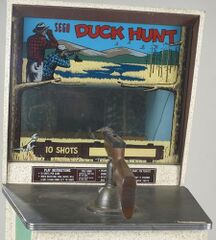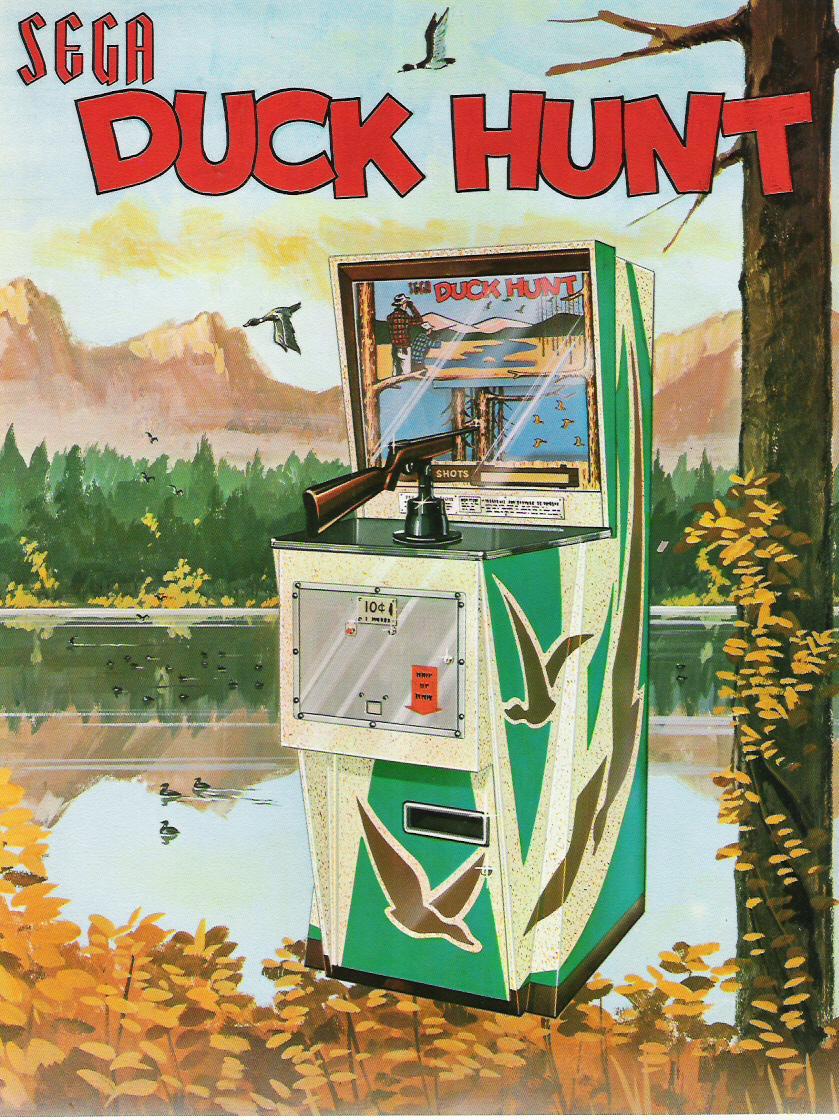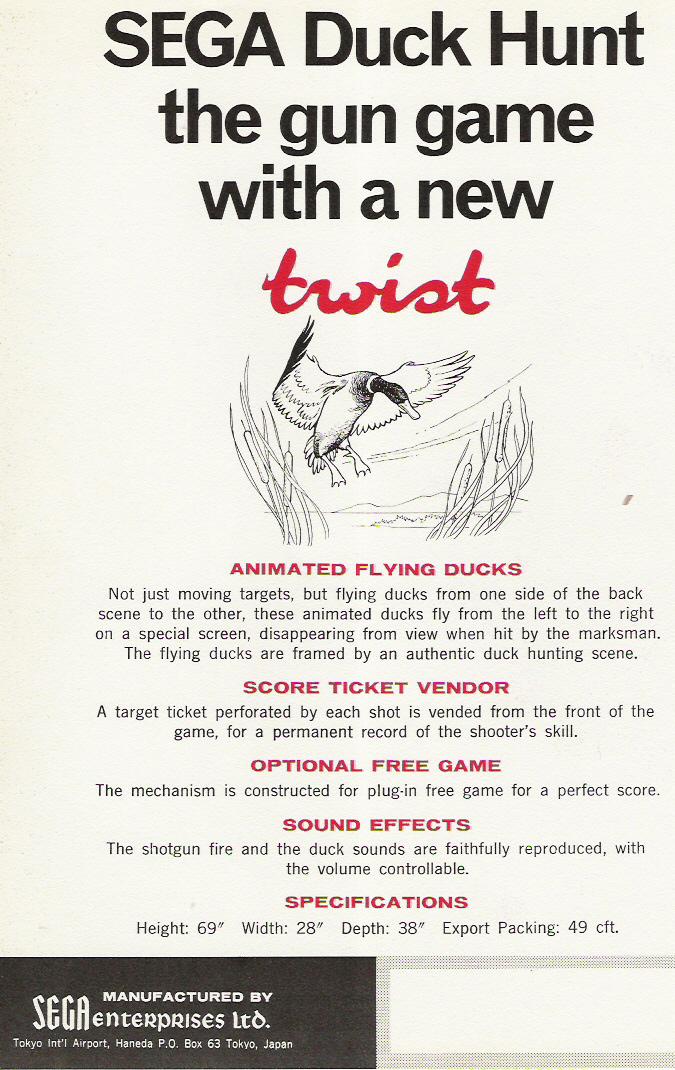Difference between revisions of "Duck Hunt"
From Sega Retro
| Line 31: | Line 31: | ||
==History== | ==History== | ||
| − | |||
In the late 1960s, Japanese companies Kasco (Kansei Seiki Seisakusho Co.) and Sega introduced a new type of electro-mechanical game, video projection games. They looked and played like later arcade video games, but relied on electro-mechanical components to produce sounds and images rather than a CRT display. They used rear video image projection to display moving animations on a video screen.{{ref|[http://classicgames.about.com/od/arcadegames/p/KillerShark.htm Killer Shark: The Undersea Horror Arcade Game from Jaws], D.S. Cohen, About.com}}{{ref|[http://shmuplations.com/kasco/ Kasco and the Electro-Mechanical Golden Age] (Interview), ''Classic Videogame Station ODYSSEY'', 2001}}{{ref|[https://www.academia.edu/12148820/Once_Upon_a_Time_on_the_Screen_Wild_West_in_Computer_and_Video_Games Once Upon a Time on the Screen: Wild West in Computer and Video Games], Academia}} | In the late 1960s, Japanese companies Kasco (Kansei Seiki Seisakusho Co.) and Sega introduced a new type of electro-mechanical game, video projection games. They looked and played like later arcade video games, but relied on electro-mechanical components to produce sounds and images rather than a CRT display. They used rear video image projection to display moving animations on a video screen.{{ref|[http://classicgames.about.com/od/arcadegames/p/KillerShark.htm Killer Shark: The Undersea Horror Arcade Game from Jaws], D.S. Cohen, About.com}}{{ref|[http://shmuplations.com/kasco/ Kasco and the Electro-Mechanical Golden Age] (Interview), ''Classic Videogame Station ODYSSEY'', 2001}}{{ref|[https://www.academia.edu/12148820/Once_Upon_a_Time_on_the_Screen_Wild_West_in_Computer_and_Video_Games Once Upon a Time on the Screen: Wild West in Computer and Video Games], Academia}} | ||
| − | ''Duck Hunt'' was one of the first arcade games to use animated image projection technology. | + | ''Duck Hunt'' was designed by [[Hisashi Suzuki]]. It was one of the first arcade games to use animated image projection technology. The game was released to test locations in 1968, before receiving a wide international release in January 1969. According to ''Cash Box'' magazine in January 1969, the game's "income at test locations has proven to be exceptionally high because of the three factors of sound effects, spectator participation, and vended target."{{magref|cb|1969-01-04|34}} |
===Legacy=== | ===Legacy=== | ||
Revision as of 18:41, 10 November 2024

| |||||||||||||||||
| Duck Hunt | |||||||||||||||||
|---|---|---|---|---|---|---|---|---|---|---|---|---|---|---|---|---|---|
| System(s): Electro-mechanical arcade | |||||||||||||||||
| Publisher: Sega Enterprises, Ltd. | |||||||||||||||||
| Developer: Sega Enterprises, Ltd. | |||||||||||||||||
| Genre: Shoot-'em-Up | |||||||||||||||||
| Number of players: 1 | |||||||||||||||||
|
This short article is in need of work. You can help Sega Retro by adding to it.
Duck Hunt, sometimes advertised under the name Duck Shoot[5], is a 1968 electro-mechanical arcade shooter game produced by Sega Enterprises, Ltd. A 25-cent video projection game, it features 10 animated ducks flying on a screen from left to right which disappear when shot with the attached shotgun controller.
The player receives ten shots, and the shot ducks are framed in a duck hunting score. Shooting the shot gun and hitting a duck produces a sound effect. Body shots score 10 points and headshots score 15 points. The game dispenses a perforated computer card-style ticket showing shooting accuracy and score when game is finished which could be used for prizes or as a permanent record of the player's score. Additionally, the game could be set to give a free game for a perfect score.
The game was innovative in a number of ways. It was notably the first arcade game with animated moving targets projected on a screen, electronic animal sound effects, a high score mechanic, and headshot mechanic. It was a commercial success and inspired similar projection-based electro-mechanical arcade games over the next several years.
Contents
Overview
It resembles a first-person light-gun shooter video game, but is in fact a video projection electro-mechanical (EM) game, using rear image projection in a manner similar to a zoetrope to produce moving animations on a screen.
This was the first electronic arcade game with animated targets displayed on a screen, in contrast to earlier EM arcade games that displayed static targets. This gave Duck Hunt the appearance of a video game, several years before the first true video games arrived in the arcades (Computer Space and Galaxy Game). Duck Hunt thus anticipated the kind of light-gun shooter video games that would later appear in the 1970s, and was the first electronic arcade game to display a first-person perspective on a screen. Duck Hunt was later updated by Midway and re-released in January 1973.
Purchase of a Duck Hunt machine comes with one roll of 3,000 paper cards. Replacement rolls could be acquired from Sega Enterprises for ¥3,000 each.[5]
Specifications
Dimensions
History
In the late 1960s, Japanese companies Kasco (Kansei Seiki Seisakusho Co.) and Sega introduced a new type of electro-mechanical game, video projection games. They looked and played like later arcade video games, but relied on electro-mechanical components to produce sounds and images rather than a CRT display. They used rear video image projection to display moving animations on a video screen.[6][7][8]
Duck Hunt was designed by Hisashi Suzuki. It was one of the first arcade games to use animated image projection technology. The game was released to test locations in 1968, before receiving a wide international release in January 1969. According to Cash Box magazine in January 1969, the game's "income at test locations has proven to be exceptionally high because of the three factors of sound effects, spectator participation, and vended target."[4]
Legacy
According to Cash Box magazine in January 1969, Sega's Duck Hunt was a "fresh approach to gun games" simulating "realistically the sport of duck hunting and embodying many" innovations, including "unusual audiovisual concepts and many new" features. The magazine listed the following innovations:[4]
- "Solid-state and electro-mechanical sound effects include gun fire and wild duck quacking."
- "Perforated targets are vended from the front of the game, for a permanent record of the shooter's skill."
- "The individual targets stimulate replay."
- "Animated ducks fly from left to right on a special screen and disappear from view when hit by the marksman."
- "Players use a simulated shotgun and are required to "lead" the ducks-as in regular duck hunting."
- "A perfect score wins an optional free game at the press of a button."
- "Head shots score 15 and body shots 10."
- "Scores are shown on the game and precision markmanship is registered on the front-vended targets."
- "The moving "sky screen" is framed by an authentic duck hunting scene."
- "The well designed game housing is attractively decorated in aqua-green and brown."
After Duck Hunt, Sega produced several more electro-mechanical arcade games based on similar technology, using rear image projection to produce moving animations on a screen. In 1969, Sega released the EM games Grand Prix, a first-person driving/racing game like Kasco's Indy 500 that projects a forward-scrolling road on a screen, and Missile, a first-person vehicle combat simulation that had a moving film strip project targets on screen and a dual-control scheme where two directional buttons move the player tank and a two-way joystick with a fire button shoots and steers missiles onto oncoming planes, which explode when hit; in 1970, Missile was released in North America as S.A.M.I. Sega's Jet Rocket in 1970 was the earliest first-person shooter and combat flight simulator game, with cockpit controls that could move the player aircraft around a landscape displayed on screen and shoot missiles onto targets that explode when hit. In 1972, Sega released Killer Shark, a first-person light gun game known for appearing in the 1975 film Jaws.
Video projection games became common in arcades of the 1970s. They combined electro-mechanical and video elements, laying the foundations for arcade video games, which adapted cabinet designs and gameplay mechanics from earlier video projection games.[8] They also occasionally used solid-state electronics for sounds (like Grand Prix, Missile and Night Rider).
The game also may have influenced Nintendo's light-gun shooters. In 1974, Nintendo's arcade light gun shooter Wild Gunman was a video projection EM game that used similar technology, but improved on it by using full-motion video projection to display live-action cowboy opponents on screen. In 1984, Nintendo released their own video game called Duck Hunt, which played similarly to Sega's 1969 electro-mechanical arcade game of the same name.
Duck Hunt may have also influenced Kasco's 1975 arcade game Gun Smoke, a light gun shooter that was the first holographic 3-D game. It was a hit in Japan, selling 6,000 cabinets there, but only 750 cabinets were sold in the US.[9] It was followed by two more holographic Kasco gun games, Samurai and Bank Robber, released between 1975 and 1977, as well as a 1976 Midway clone, Top Gun. The first holographic video games would later be Sega's Time Traveler (1991) and Holosseum (1992).[10]
Promotional material
Photo gallery
References
- ↑ http://thetastates.com/eremeka/1969prior.html (Wayback Machine: 2023-08-21 09:33)
- ↑ File:CashBox US 1970-11-21.pdf, page 57
- ↑ 3.0 3.1 Billboard (December 28, 1968), page 33
- ↑ 4.0 4.1 4.2 Cash Box, "January 4, 1969" (US; 1969-01-04), page 34
- ↑ 5.0 5.1 1977 Sega Price List, page 6
- ↑ Killer Shark: The Undersea Horror Arcade Game from Jaws, D.S. Cohen, About.com
- ↑ Kasco and the Electro-Mechanical Golden Age (Interview), Classic Videogame Station ODYSSEY, 2001
- ↑ 8.0 8.1 Once Upon a Time on the Screen: Wild West in Computer and Video Games, Academia
- ↑ Gun Smoke
- ↑ Holograms: A Cultural History, page 179





